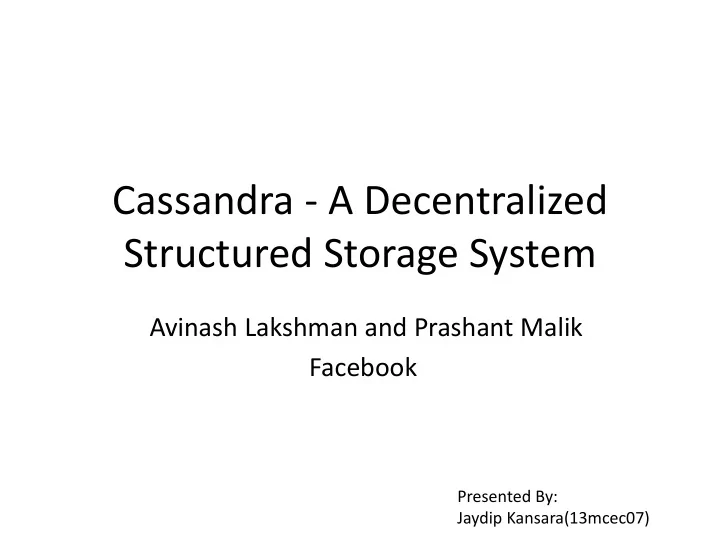

Cassandra - A Decentralized Structured Storage System Avinash Lakshman and Prashant Malik Facebook Presented By: Jaydip Kansara(13mcec07)
Agenda • Outline • Data Model • System Architecture • Experiments
Outline • Extension of Bigtable with aspects of Dynamo • Motivations: – High Availability – High Write Throughput – Fail Tolerance
• Originally designed at Facebook • Open-sourced • Some of its myriad users: • With this many users, one would think – Its design is very complex – We in our class won ’ t know anything about its internals – Let ’ s find out!
Why Key-value Store? • (Business) Key -> Value • (twitter.com) tweet id -> information about tweet • (kayak.com) Flight number -> information about flight, e.g., availability • (yourbank.com) Account number -> information about it • (amazon.com) item number -> information about it • Search is usually built on top of a key-value store
Number of Nodes
CAP Theorem • Proposed by Eric Brewer (Berkeley) • Subsequently proved by Gilbert and Lynch • In a distributed system you can satisfy at most 2 out of the 3 guarantees 1. Consistency: all nodes have same data at any time 2. Availability: the system allows operations all the time 3. Partition-tolerance: the system continues to work in spite of network partitions • Cassandra – Eventual (weak) consistency, Availability, Partition-tolerance • Traditional RDBMSs – Strong consistency over availability under a partition
Data Model • Table is a multi dimensional map indexed by key (row key). • Columns are grouped into Column Families. • 2 Types of Column Families – Simple – Super (nested Column Families) • Each Column has – Name – Value – Timestamp
Data Model keyspace column family column settings settings name value timestamp * Figure taken from Eben Hewitt’s (author of Oreilly’s Cassandra book) slides.
System Architecture • Partitioning How data is partitioned across nodes • Replication How data is duplicated across nodes • Cluster Membership How nodes are added, deleted to the cluster
Partitioning • Nodes are logically structured in Ring Topology. • Hashed value of key associated with data partition is used to assign it to a node in the ring. • Hashing rounds off after certain value to support ring structure. • Lightly loaded nodes moves position to alleviate highly loaded nodes.
Replication • Each data item is replicated at N (replication factor) nodes. • Different Replication Policies – Rack Unaware – replicate data at N-1 successive nodes after its coordinator – Rack Aware – uses ‘Zookeeper’ to choose a leader which tells nodes the range they are replicas for – Datacenter Aware – similar to Rack Aware but leader is chosen at Datacenter level instead of Rack level.
Partitioning and Replication h(key1) 1 0 E A N=3 C h(key2) F B D 1/2 * Figure taken from Avinash Lakshman and Prashant Malik (authors of the paper) slides. 18
Gossip Protocols • Network Communication protocols inspired for real life rumour spreading. • Periodic, Pairwise, inter-node communication. • Low frequency communication ensures low cost. • Random selection of peers. • Example – Node A wish to search for pattern in data – Round 1 – Node A searches locally and then gossips with node B. – Round 2 – Node A,B gossips with C and D. – Round 3 – Nodes A,B,C and D gossips with 4 other nodes …… • Round by round doubling makes protocol very robust.
Gossip Protocols • Variety of Gossip Protocols exists – Dissemination protocol • Event Dissemination: multicasts events via gossip. high latency might cause network strain. • Background data dissemination: continuous gossip about information regarding participating nodes – Anti Entropy protocol • Used to repair replicated data by comparing and reconciling differences. This type of protocol is used in Cassandra to repair data in replications.
Cluster Management • Uses gossip for node membership and to transmit system control state. • Node Fail state is given by variable ‘phi’ which tells how likely a node might fail (suspicion level) instead of simple binary value (up/down). • This type of system is known as Accrual Failure Detector.
Accrual Failure Detector • If a node is faulty, the suspicion level monotonically increases with time. Φ (t) k as t k Where k is a threshold variable (depends on system load) which tells a node is dead. • If node is correct, phi will be constant set by application. Generally Φ (t) = 0
Facebook Inbox Search • Cassandra developed to address this problem. • 50+TB of user messages data in 150 node cluster on which Cassandra is tested. • Search user index of all messages in 2 ways. – Term search : search by a key word – Interactions search : search by a user id Latency Stat Search Interactions Term Search Min 7.69 ms 7.78 ms Median 15.69 ms 18.27 ms Max 26.13 ms 44.41 ms
Comparison with MySQL • MySQL > 50 GB Data Writes Average : ~300 ms Reads Average : ~350 ms • Cassandra > 50 GB Data Writes Average : 0.12 ms Reads Average : 15 ms • Stats provided by Authors using facebook data.
Thank You
Recommend
More recommend